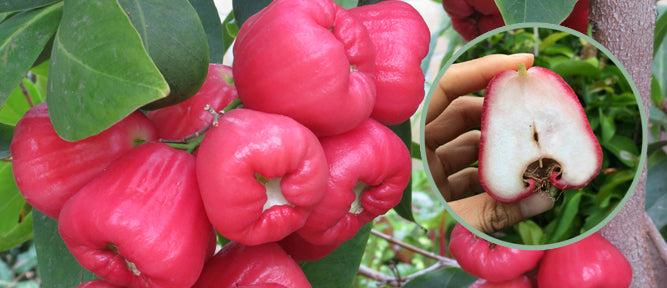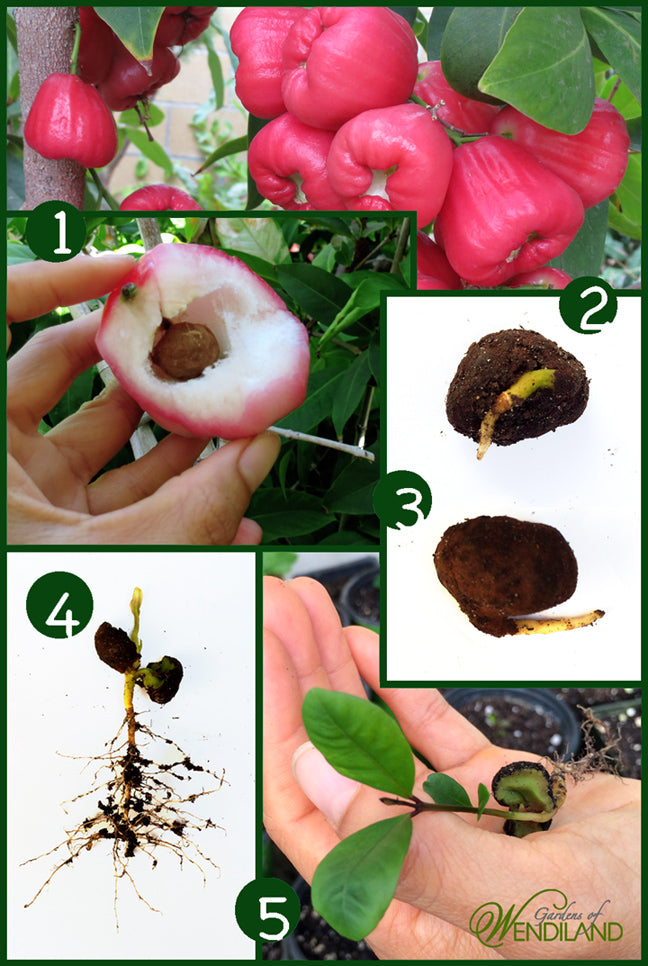All About Jambu Wax Apple September 06 2016

A few years ago I posted my first video on our Jambu tree on Youtube, and viewers' responses had exceeded my expectation. Many were surprised this tree can grow in the mainland US, so their interest in getting a hold of these seedlings became a question I've been asked often. Today I am very excited to tell you these darling seedlings will be available here! They were grown from the fruits of our tree. Not every fruit contains a seed so there's limited amount of seedlings available.
Jambu In My Childhood Memory
These fruits in the garden brought back memories of my childhood living in southeast Asia. It's hot most of the year in Vietnam so my dad often came home after work with papaya or jambu for me. He held the jambu between his palms, crossed his fingers and squeezed the fruit. A loud squish and a pop sound would follow then he gave me the two halves of the fruit he broke apart. It was sweet, crunchy and juicy, a taste I will not forget.
 Flowers of the Jambu
Flowers of the Jambu
After new leaves grow back in the spring, tiny clusters of flower buds start to form. When they bloom, they make the bees busy at work. Flowers can self pollinate to develop fruits.
How Jambu Taste
This is one of the most beautiful trees when it's covered with fruits. Fruits are crunchy, delicately sweetened, lightly fragrant like nectar, and just so refreshing! The texture of the exterior is like a pear, and the interior is like a watermelon. During the warmest time of the year, these fruits turn bright pink/red, tempting you to reach out to grab a few.

Who Can Grow Jambu?
Jambu is a sub tropical fruit tree that can adapt to places with a mild winter. Regions that freezes over in the winter can grow them in pots, and bring indoor during the colder period.
Where To Plant Jambu?
For places with mild winter, keep the seedling in a pot until it reaches about 1.5-2 ft tall before planting in the ground. It's best to plant the young tree in the ground in early spring so it has most of the year to adjust to its environment.
A seedling is more sensitive to the cold than a mature tree. Whether you are growing it in a pot or in the ground, find the warmest area where it gets the longest hours of sun. Full sun is best, or at least 6 or more hours of direct sun is preferred. The more sun it gets, the more flowers the tree will produce.
For regions that freezes over in the winter can grow them in pots, and bring indoor during the colder period. Keep tree in the warmest, brightest area in the room.
Water Requirements
The tree can endure dry soil for short period, but best to keep soil moist at all time. Leaves curling, folding inward is a sign for lack of water. Increase watering when the days get warmer. If there's not enough water given in the summer, the leaves may fold inward and get burned from the intense high sun. When the tree is flowering or setting fruits, increase watering slowly.
In the winter, cut back watering. This is time for the tree to rest since it's growth has slowed. If soil is too damp, it keeps the cold in the soil longer which can harm the roots.
Soil and Fertilizer Requirements
Grow Jambu in well drained soil to prevent waterlogging. Especially if you get winter rain, you want the water to drain quickly so roots are not sitting in cold water for long period.
Mix compost, warm casting, Perlite or sand, with native soil for growing it in the ground. If you are growing in a pot, organic potting mix for fruit trees can be purchased at any local nursery.
When the tree puts out new growth during spring, use an organic fertilizer that is higher in nitrogen to give it a boost. When flowers come, add organic fertilizer that is higher in phosphorus. You will see these indicated on the package of fertilizers so it's not absolutely necessary to remember these terms!
Aside from fertilizers, I like adding fresh compost such as vegetable scraps from the kitchen back in the soil. You can also make worm casting tea to water.
Protecting Jambu From The Cold
A young tree will need more cold protection than an established tree. Jambu begins to drop leaves as the temperature drops. By winter, my tree in Southern California loses about 30% more of less of its leaves. These fallen leaves make an excellent insulation covering the top of soil. Otherwise, mulch can be added to the soil top to protect the roots.
How Long Does It Take To Fruit Growing From Seed?
While every plant and its environment is different, I can only speak from my personal experience. Our tree was grown from seed, and it produced a few fruits by 3rd year. Each year after, the tree produced more fruits than the last!
